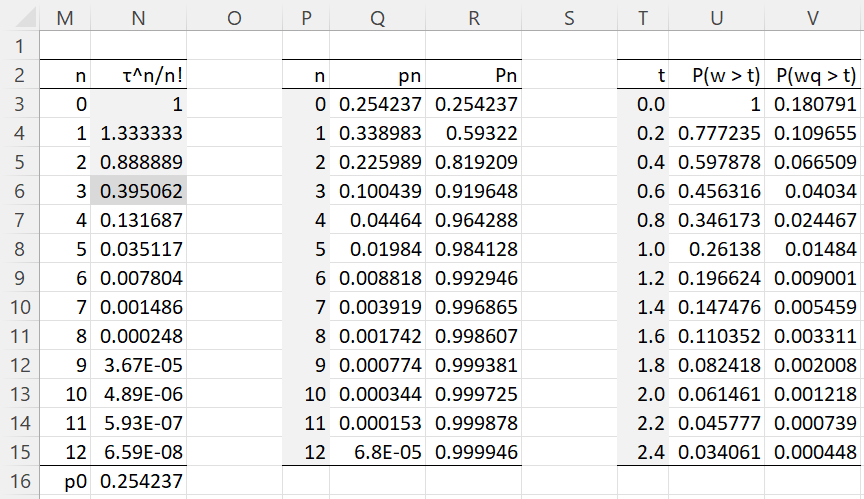Basic Concepts
The M/M/s queueing model describes the same queueing process as the M/M/1 queueing model except that s servers are used where s is a positive integer. When s = 1, this model is equivalent to the M/M/1 model.
agOnceain, customer arrivals follow an exponential distribution at the rate of λ. Servicing also follows an exponential distribution with a service rate of μ for each server. We assume that when more than one server is available, the customer chooses randomly.
This time we set τ = λ/μ and ρ = λ/(μs). We will assume that ρ < 1 since, in this case, the process arrives at a steady-state (as defined in Queueing Theory).
Balance Equations
The steady-state equations for the M/M/s model are as follows.
μp1 = λp0
(λ + nμ)pn = λpn-1 + (n + 1)μpn+1 for n < s
(λ + sμ)pn = λpn-1 + sμpn+1 for n ≥ s
Number of customers in the system
The probability pn that n customers are present in an M/M/s model in a steady-state can be calculated by the following formulas
We can use the notation Pn = p0 + p1 + ⋅⋅⋅ pn. In particular, we use the notation C as the probability that when a new customer arrives it finds all the servers occupied and so the customer must queue. It turns out that
![]()
Key properties
The following mean values hold for M/M/s models in a steady state:
The corresponding variances are
![]()
where if τ ≠ s – 1
![E[w^2] tau not s + 1](https://real-statistics.com/wp-content/uploads/2023/02/image016.png)
while if τ = s – 1
![]()
Distribution of w and wq
The following formulas hold for M/M/s models in a steady state.
When τ ≠ s – 1

while if τ = s – 1
Example
Example 1: Calculate the various parameters for an M/M/s queueing model with 3 servers where λ = 1.5 and μ = 2.
The results are shown in Figures 1 and 2.
Figure 1 – M/M/s queueing model (part 1)
Columns M and N of Figure 2 are used to calculate p0. Cell N3 contains the formula =G$8^M3/FACT(M3). The other values in column N are filled in by highlighting range N3:N12, and pressing Ctrl-D. The value for p0. (in cell N16) is calculated via the formula
=1/(SUM(OFFSET(N3,0,0,B4,1))+OFFSET(N3,B4,0,1,1)/(1-G6))
For Example 1 with s = 3, this formula is equivalent to =1/(SUM(N3:N5)+N6/(1-G6). The advantage of the above formula is that it works with any value of s (although the values in column N need to be extended for s > 12).
Figure 2 – M/M/s queueing model (part 2)
Note that cell Q4 contains the formula
=Q$3*IF(P4<B$4,N4,G$8^P4/(FACT(B$4)*B$4^(P4-B$4)))
and R4 contains =R3+Q4, and similarly for the other formulas in columns Q and R.
Cell U3 contains the formula
=EXP(-B$3*T3)*(1+G$10*IF(G$9=0,B$3*T3,(1-EXP(-B$3*T3*G$9))/G$9))
and cell V3 contains the formula
=G$10*EXP(-B$4*B$3*T4*(1-G$6))
The other formulas in columns U and V are similar.
Worksheet Functions
Excel Functions: The Real Statistics Resource Pack supports the following array function.
MMs(λ, μ, s, lab): returns a column array with the L, Lq, W, Wq, ρ for the M/M/s queueing model with s servers and exponential arrival and service rates with mean arrival rate λ and mean service rate μ.
If lab = TRUE (default FALSE) then an extra column of labels is appended to the output. In addition, the following non-array functions are also supported.
MM1Pn(λ, μ, s, n, cum) = pn for the M/M/1 queueing defined by s, λ, and μ if cum = FALSE (default) and Pn otherwise.
MM1W(λ, μ, s, t) = P(w > t) for the M/M/1 queueing defined by s, λ and μ
MM1Wq(λ, μ, s, t) = P(wq > t) for the M/M/1 queueing defined by s, λ and μ
You can obtain the values in range F2:G6 of Figure 1 via the array formula =MMs(B2,B3,TRUE). You can obtain the values in Figure 2 by inserting =MMsPn(B$2,B$3,M3) in cell N3 and =MMsPn(B$2,B$3,M3,TRUE) in cell O3, highlighting N3:O15, and pressing Ctrl-D. Finally, you can obtain the values in Figure 3 by inserting =MMsW(B$2,B$3,Q3) in cell R3 and =MMsWq(B$2,B$3,Q3) in cell S3, highlighting R3:S15, and pressing Ctrl-D.
Examples Workbook
Click here to download the Excel workbook with the examples described on this webpage.
References
Ross, S. M. (2014) Introduction to probability models, 11th Ed. Academic Press
https://ebin.pub/introduction-to-probability-models-11nbsped-0124079482-9780124079489.html
Sztrik, J. (2021) Basic queueing theory
https://irh.inf.unideb.hu/~jsztrik/education/16/SOR_Main_Angol.pdf
Shores, T. S. (2017) Queueing theory basics and models
No longer available online
Wikipedia (2023) M/M/c queue
https://en.wikipedia.org/wiki/M/M/c_queue


Good day! The expression of pn for n < s contains the error. Variable τ should be raised to the power of variable n, not variable s.
With best wishes, Peter.
Hello Peter,
Thanks for catching this error. I have now corrected this mistake on the webpage.
I appreciate your help in improving the quality of the webasite.
Charles